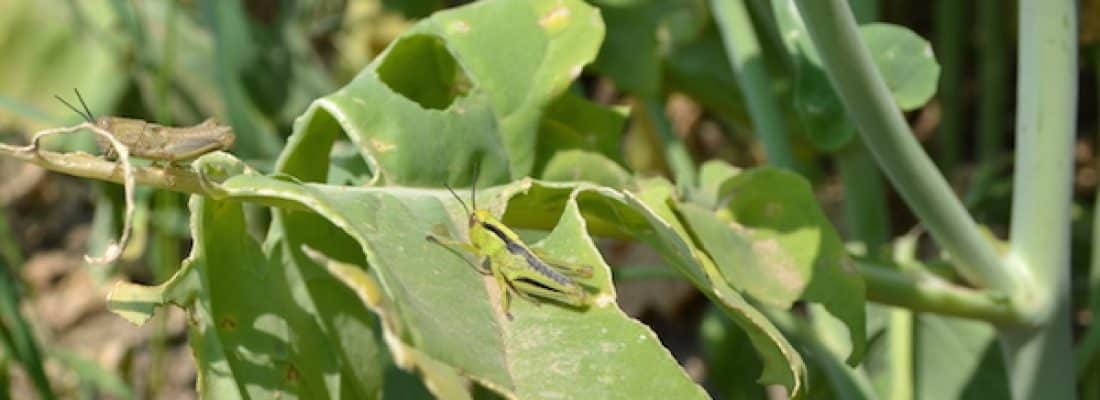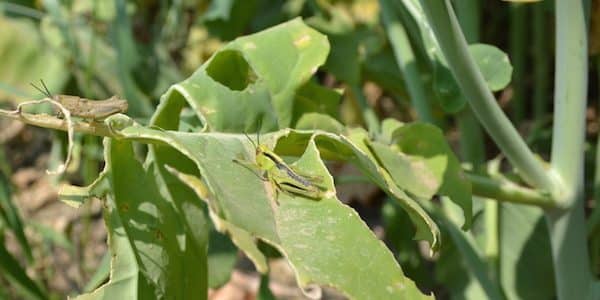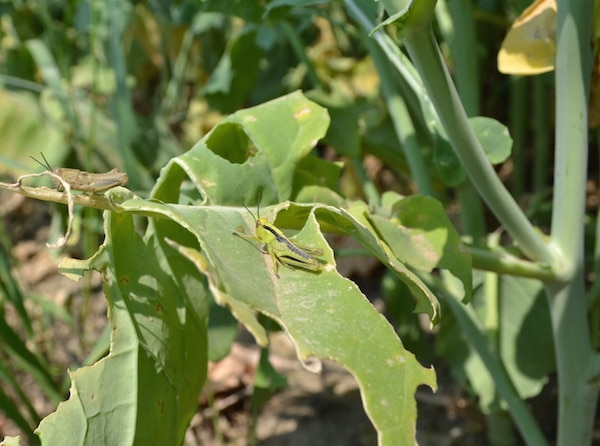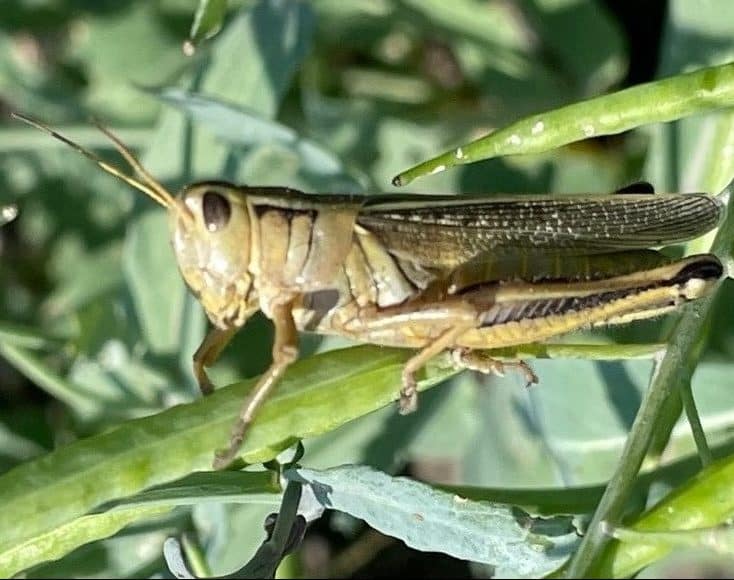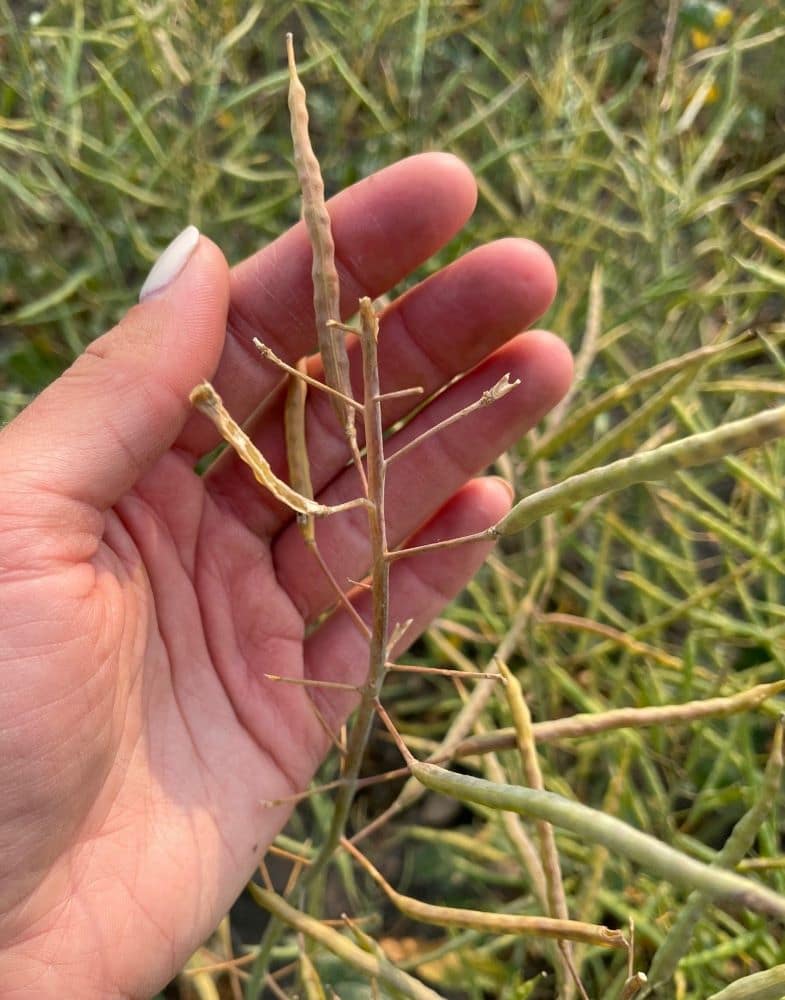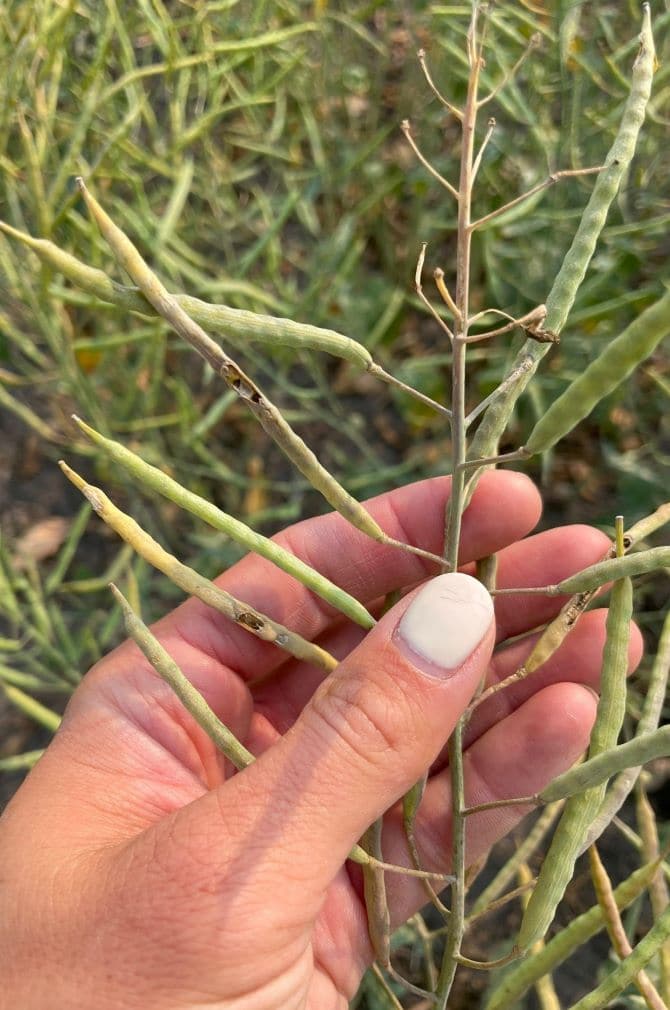A common insect pest in canola, grasshoppers should be scouted for, identified and insect counts can be considered per area (typically per square metre). Monitoring grasshopper populations in crops includes assessing damage, understanding thresholds and considering potential management strategies, if warranted.
Identification and life cycle
There are about 180 species of grasshoppers in Canada, and of these there are four common grasshoppers found in the Canadian Prairies that can at times get to high levels and become pests of crops. These are the twostriped [Melanoplus bivittatus (Say)], migratory [Melanoplus sanguinipes (Fabricius)], clearwinged (Camnula pellucida Scudder) and Packard (Melanoplus packardii Scudder) species.
There is one generation each year, beginning with eggs that overwinter in the soil. Around late-May, once the soil temperature is warm enough, the nymphs emerge and can be present as late as early July. Adults can be found between late June until about mid-September 1.
Colour varies between and sometimes within species, as does size. All the potential pest species have relatively short antennae compared to some non-pest grasshoppers, such as katydids, and belong to a family of grasshoppers called the short-horned grasshoppers 2, 3.
Damage

Grasshoppers can feed on a range of plants, with different preferences between species. The species which are more likely to be found in canola fields are the twostriped and migratory grasshoppers, although canola is not generally viewed as a preferred feeding target. Clearwinged grasshopper prefers grasses and is unlikely to feed on canola 1, however it can cause feeding damage in safflower 4.
Both nymphThe juvenile or immature stage (ex. of an insect) which goes through incomplete metamorphosis. More and adult grasshoppers feed on canola leaves, stems and pods, but the most significant damage is done when feeding on pods 2.
Grasshoppers can be more of an issue in hot, dry conditions. This is partially because insects, as cold-blooded creatures, eat more and grow faster in hot weather. Another reason is that hot, dry weather limits fungal infection, which can significantly impact some species of grasshoppers. Also, in dry weather, reduced natural vegetation can force grasshoppers to move to cultivated crops 5.
Since grasshopper development is impacted by temperatures, their development can be estimated with model simulations, such as those provided by the Prairie Pest Monitoring Network on the migratory grasshopper [Melanoplus sanguinipes (Fabricius)].
However, note that there are limitations to the degree-day grasshopper development predictions (as they are estimations, often based on air temperature), and conditions vary from site to site based on soil, crop, landscape, and previous year’s weather during breeding season, so they should be considered more of a general guideline.
Improvements continue to be made to temperature-dependent insect development models 6. Still, variance in developmental timing is a challenge for forecasting. For example, even after many days with very hot June and July temperatures (which would accumulate a large number of GDDs) many grasshopper species will still be maturing by mid-July. As well, in similar conditions (when a large number of GDDs have been accumulated) some species may still be found in multiple development stages (such as instars 2 through 5 plus adult stage) 7.
Monitoring and thresholds
Monitoring
For population distribution information, see the Prairie Pest Monitoring Network’s historical grasshopper risk and grasshopper forecast maps.
Monitoring for grasshopper can begin at the canola rosette stage and continue into ripening 2. The PPMN recommends scouting on warm days when grasshoppers are more active and easier to observe.
Counting grasshoppers can be a challenge because as soon as you walk into an area, grasshoppers take off (and do not cooperate with attempts to count them). So entomologists have come up with a more practical scouting technique. It involves three steps:
1. Walk into a few areas of the field. For example, you can start from a corner of the field and work your way along a line to the field centre, then to another side 3. If grasshoppers jump around with every step you take, and seem to be general throughout the field, try to estimate approximate levels, but don’t worry if you can’t be too accurate.
2. Look for feeding and identify the species. Use the PPMN’s Grasshopper diversity and photos of nymphs, adults, and non-grasshopper species to help you. Lots of clearwinged grasshoppers which are not feeding on the canola won’t warrant considering control (while migratory or twostriped grasshoppers may). If there is more feeding damage than there was the last time you checked, and the problem appears to be grasshopper feeding, spraying may be warranted, particularly if pods are being targeted.
3. Control grasshoppers, if needed, when wings only partially cover the abdomen. At this stage, they’re hopping but not flying, and much easier to control. Note: Some insecticides are not particularly effective against winged grasshoppers 8. The PPMN’s grasshopper lifecycle, damage and scouting and economic thresholds can support sound management decisions enabling the preservation of beneficial arthropods and mitigation of economic losses.
For a precise method to monitor adult grasshopper populations, see the Prairie Pest Monitoring Network’s protocol. This includes a density estimate, to determine the number of grasshoppers per square metre, to compare against economic thresholds and sweep-net sampling to ‘detect’ grasshoppers or monitor species composition.
Density estimate

- At each field, measure off 50 metres on the level road surface and mark both starting and finishing points using markers or specific posts on the field margin.
- Starting at one end, walk for 10 m towards the finish point and count the number of grasshoppers observed jumping in a width of 1m. Record the number counted.
- While counting, a meter stick can be carried as a visual tool to give perspective for a one meter width. With experience, one can often visualize the necessary width and a meter stick may not be required. A hand-held counter can be useful in counting while the observer counts off the required distance.
- Repeat the counting process while walking each 10 m increment until five counts from both 50 m transects have been recorded.
- Calculate the average number of grasshoppers per square meter in each transect by dividing the total number of grasshoppers counted by the total distance walked in the transect.
- Compare counts to the following damage levels associated with pest species of grasshoppers:
- 0-2 per m² – None to very light damage
- 2 per m2 – Lentil pod and flax boll feeding economic thresholdAn economic threshold is the level of infestation (ex. pest insect density) at which lost yield (ex. due to feeding/insect pest damage) exceeds the cost of the chemical and its application. More
- 2-4 per m² – Very light damage
- 4-8 per m² – Light damage
- 8-12 per m² – Moderate damage (action thresholds in cereals and canola)
- 12-24 per m² – Severe damage
- >24 per m² – Very severe damage
Research into insect surveillance, such as the ‘Detection, surveillance and management of weed, insect and disease pests that threaten the economic viability of crop production and the environmental health of Prairie agro-ecosystems’ project continues to be an area of interest.
Sweep net sampling:
To monitor species composition, use a sweep to collect adult grasshoppers at each location.
- Take at least 5 to 25 sweeps (180 ̊) at each location and put the contents of the net into a clear plastic bag to observe the contents of the net. Estimate the number of species present and record the species names.
- Use the total number of grasshoppers in the sample and the number of each species present to estimate the per cent of the total population accounted for by each species.
- Record and report species percentages if accurately identified.
Thresholds
Action threshold is likely >12 (or 8-12) grasshoppers/m2 and it is better to control younger instars, as the damage grasshoppers cause continues to accumulate from nymphThe juvenile or immature stage (ex. of an insect) which goes through incomplete metamorphosis. More through adult stages 2, 9. The higher end of that range may be more appropriate in a typical canola crop as, given a choice, most grasshopper species prefer grass and cereals to canola 5.
University of Lethbridge entomologist Dan Johnson suggests that the low end of the grasshopper economic thresholdAn economic threshold is the level of infestation (ex. pest insect density) at which lost yield (ex. due to feeding/insect pest damage) exceeds the cost of the chemical and its application. More in canola is more applicable in dry conditions, with the potential for it to be even slightly lower than seven grasshoppers per square metre, under very specific situations (hot, very dry) 7.
In 2024, Dr. Tansey (Provincial Insect/Pest Management Specialist for the Saskatchewan Ministry of Agriculture at the time) provided a preliminary summary of available thresholds used to monitor and manage grasshoppers to the PPMNThe Prairie Pest Management Network (PPMN) is a coordinated insect surveillance program involved in developing monitoring protocols and in coordinating and conducting insect population monitoring of field crops for the Prairies. The PPMN is comprised of field crop entomologists who conduct research and actively monitor insect populations to support crop protection programs. It includes researchers from Agriculture and Agri-Food Canada, Manitoba Agriculture, Food and Rural Initiatives, Saskatchewan Ministry of Agriculture, Alberta Agriculture and Forestry, and universities. Industry stakeholders also provide regular input and valuable insight. More for consideration, which suggests in field and in ditch threshold values. The proposed thresholds are 30-45 per square metre for grasshopper nymphs (up to fourth instarA developmental stage within one life stage (ex. of an insect) More) and 12-14 per square metre for fifth instarA developmental stage within one life stage (ex. of an insect) More grasshopper nymphs and adults in canola (or soybean) fields. In addition, grasshopper thresholds of 50-75 per square metre for nymphs (up to fourth instarA developmental stage within one life stage (ex. of an insect) More) and 24-50 per square metre for fifth instarA developmental stage within one life stage (ex. of an insect) More grasshopper nymphs and adults in canola (or soybean) ditches were proposed 10.
Management
Cultural options
According to the Western Committee on Crop Pests Guide to Integrated Control of Insect Pests of Crops’ Insect Management in oilseed crops in Western Canada guidelines, some practices which may impact grasshoppers include:
- destroying green growth on stubble in the spring (when grasshoppers are hatching) to potentially starve young grasshoppers.
- Growing barrier strips of a non-preferred crop like oats or peas next to an infested area at the margin of fields may act as a bit of a barrier to delay young grasshoppers from feeding on susceptible crops 11.
If populations are significant and crop feeding has begun, a spray or bran bait application around field edges may be enough to reduce the threat. Grasshoppers are easier to manage when they’re small — when the majority are in the third to fourth instarA developmental stage within one life stage (ex. of an insect) More (as there would be too many unhatched eggs when the majority are still in the earliest instars). Except in cases where there are extremely high populations feeding on crop along the edges, ideal timing for grasshopper management is when you are starting to see wing buds on some of the older grasshoppers. Hatch of grasshopper eggs can often be quite prolonged, and applying controls too early can result in some of the later part of the hatch being missed 12.
If canola is the only green material nearby, grasshoppers can cause significant damage as they move in from drying pasture, cut hay or a nearby crop that is becoming unpalatable. Grasshoppers are often at higher numbers at field margins, making a targeted spray possible. If the insecticide of choice for grasshopper control is registered and within pre-harvest interval for the neighbouring crop, consider spraying into the crop or crop stubble that has been hosting the grasshoppers to provide a bit of a buffer area where the insecticide can begin to work as they move towards your crop of concern. A bran bait, EcoBran, is particularly effective on younger grasshoppers and field margins. Scout to see where the grasshopper migration margin exists if using this approach.
Insecticide options
There are several insecticide control options for grasshoppers in canola in the Prairies, if damage, timing and grasshopper numbers warrant it. It is best to target spraying for nymphs to use the lowest recommended rates and to reduce the area requiring treatment. Grasshoppers present before late-May are not likely pest species and insecticides are much less effective in protecting crops once grasshoppers are adults 1.
Also note that there are grasshopper species that are not pests, but at the nymphThe juvenile or immature stage (ex. of an insect) which goes through incomplete metamorphosis. More stage look very similar to pest species. As a general rule, control is not needed for these non-pest grasshoppers, which can be seen flying before June, have coloured (red, yellow, orange or black) hindwings which can be seen when they are flying, or make sounds (e.g. singing, calls, clacks) on the ground or in flight 13.
For quick reference, check the Insecticide options for 2024 document. For a complete list of insecticide control options for grasshoppers in canola in the Prairies, see Table 1.
Table 1. Grasshopper control option in canola
Note – ALWAYS CONSULT THE INSECTICIDE LABEL BEFORE APPLYING ANY INSECTICIDE
*Insecticide Group: D=diamides, B=butenolides, N=neonicotinoids, S=sulfoximines, P=pyrethroids, C=carbamates, OP=organophosphates
** LD50 values represent the relative toxicity of a pesticide. They represent the dose (in milligram per kilogram body weight) that will kill 50 percent of the test animals. Thus the lower the number the greater the toxicity. Values given are for oral LD50
***Talk to your grain buyer prior to application
Source: Alberta Crop Protection Guide 2024 (The Blue Book) and the Saskatchewan Guide to Crop Protection
When applying an insecticide, always check the Spray to Swath calculator to make note of and follow the pre-harvest intervals (the minimum number of days that must pass between product application and cutting your crop by swathing or straight-cutting) 14.
For best results, also avoid spraying on hot days. At temperatures above 25°C, grasshoppers can metabolize insecticide more quickly, and it can be less effective. Moderately warm days result in slower insecticide metabolization and better control 5.
Footnotes
- Philip, H., Mori, B.A., & Floate, K.D. 2018. Field crop and forage pests and their natural enemies in Western Canada: Identification and management field guide. Agriculture and Agri-Food CanadaAgriculture and Agri-Food Canada is a department of the Government of Canada. More, Saskatoon, SK.[↩][↩][↩]
- Canola Council of Canada. 2015. Canola Insect Scouting Guide[↩][↩][↩][↩]
- Western Grains Research Foundation. 2021. Pest & Predators Field Guide. Field Heroes campaign.[↩][↩]
- Johnson, D.L., & Mündel, H.H. 1987. Grasshopper feeding rates, preferences, and growth on safflower. Annals of Applied Biology, 111, 43–52. https://doi.org/10.1111/j.1744-7348.1987.tb01431.x[↩]
- Canola Council of Canada. 2018. Grasshopper: Thresholds and scouting tips. Canola Watch[↩][↩][↩]
- Lactin, D. J., Holliday, N. J., Johnson, D. L., & Craigen, R. 1995. Improved Rate Model of Temperature-Dependent Development by Arthropods. Environmental Entomology, 24(1), 68–75. https://doi.org/10.1093/ee/24.1.68[↩]
- Direct communication in July 2021 with Dan Johnson, University of Lethbridge entomologist[↩][↩]
- Canola Council of Canada. Grasshopper management in canola: Thresholds, identification, and control strategies. Canola Watch Fundamentals[↩]
- Prairie Pest Monitoring Network. 2024. Monitoring Protocol for Grasshoppers[↩]
- Tansey, J., Otani, J., & Vankosky, M. 2024. Grasshoppers. Weekly Update: Released June 21, 2024. Available online on June 26, 2024[↩]
- Western Committee on Crop Pests Guide to Integrated Control of Insect Pests of Crops. 2021. Insect management in oilseed crops in Western Canada. Retrieved from: https://westernforum.org/Documents/WCCP/WCCP_documents/WCCP_Guidelines/WCCP_20/Oilseeds-WCCP-2021-Final.pdf[↩]
- Canola Council of Canada. 2015. Insect update: Grasshopper, diamondback, lygus, CSPW. Canola Watch[↩]
- Western Grains Research Foundation. 2021. Pest & Predators Field Guide. Field Heroes campaign[↩]
- Canola Council of Canada, Pulse Canada, Cereals Canada, Barley Council of Canada and Prairie Oat Growers Association. 2021. Spray to Swath Interval Calculator (Canola). Keep it Clean initiative[↩]
